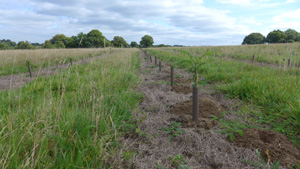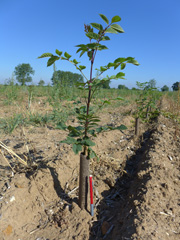Summary

To identify trees with potential in a disease resistance breeding programme, it is necessary to screen large numbers of individuals which have been exposed to the disease in question. In 2013, Forest Research set up field trials in 14 locations in south-east England where ash dieback was known to be present in the wider environment. The field trials contained around 155,000 ash trees which had been growing in forest nurseries the UK and Ireland but which could no longer be sold to the open market. Plants raised from fifteen different seed sources were obtained, spanning ten of the UK’s native tree seed zones alongside Irish, French and German ash trees. The health status of trees in the trials was monitored for three (14 trials) or four (6 trials) consecutive years following onset of disease symptoms.
This project ran from February 2013 until March 2019, although some of the experiment sites have been retained and taken forward into the Living Ash Project phase II for longer term monitoring.
Site and preparation
 Certified disease-free trees have been sourced from various UK nurseries, representing ash from 10 British seed zones, a French source, a German source, a Future Trees Trust seed orchard of ash already selected for their better form and growth rate, and also from two sources in Ireland.
Certified disease-free trees have been sourced from various UK nurseries, representing ash from 10 British seed zones, a French source, a German source, a Future Trees Trust seed orchard of ash already selected for their better form and growth rate, and also from two sources in Ireland.
Nearly 155,000 young trees have been planted in replicated trials at 14 sites across 48 hectares in East Anglia and Kent. The sites have been fenced to prevent wildlife access. These areas have been chosen for the trials to give the trees the greatest chance of being exposed to Chalara spores and thereby become infected.
Survival after planting across all sites is around 95%. Growth of some seedlings in the first growing season is as much as 40 cm. Where plants have died, it was most likely due to establishment problems and drought. On one site with heavy clay soil, the planting slit had opened up in places and exposed the roots of the trees.
Fruiting bodies of Chalara fraxinea are now being seen in areas of high infection so it’s likely that spores will soon be drifting across East Anglia and Kent, hopefully infecting the ash trees in the trials. Fera is monitoring spore levels in woodlands across the region, which will give us an idea of the numbers of spores at the trial sites.
Research Objectives
- Source disease free seedlings of common ash (Fraxinus excelsior) representing native seed zones of the British Isles
- Liaise with NGO’s and private landowners to identify suitable planting sites in areas in south-east England where ash dieback has been reported
- Determine whether there are differences among seed sources in the response to ash dieback infection
- Observe and monitor disease development and tree survival
- Select tolerant trees for future breeding work
Latest Update
- 14 sites identified and 154,464 trees planted by June 2013.
- First year survival 96% across all 14 sites (81% minimum, 99% maximum)
- Ash dieback symptoms observed on most sites in late summer 2014.
- Presence of Hymenoscyphus fraxineus confirmed on trial trees at all 14 sites via PCR by 2015
- From 2015-2018, infection spread throughout the trial sites. The 2018 assessment found only 1% of trees lacked symptoms, although nearly all of these had shown symptoms in previous years.
- Despite a lack of completely resistant (immune) trees, 50% of the trees that were first infected in 2015 were still alive in Autumn 2018 – trees which we classify as ‘putatively tolerant’.
- There were significant differences among provenances, with a very slight relationship between latitude of seed source and proportion of tolerant trees (northern seed sources contained a higher proportion of ‘putatively tolerant’ trees).
- Eight of the trials have now been closed and handed back to landowners after selecting and regrafting their most promising trees for future breeding work.
- Six of the trials have been retained and taken forward into the Living Ash Project phase II for longer term monitoring
